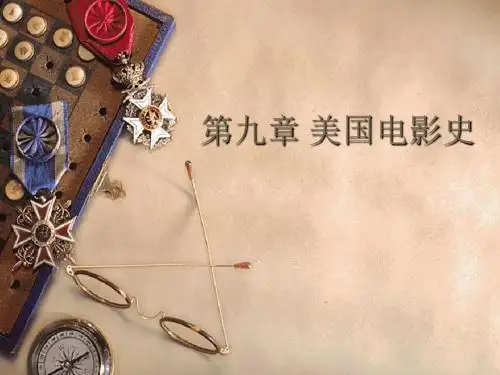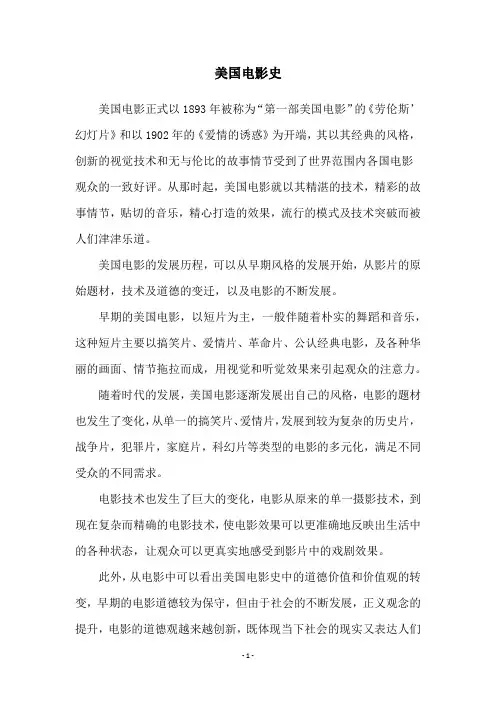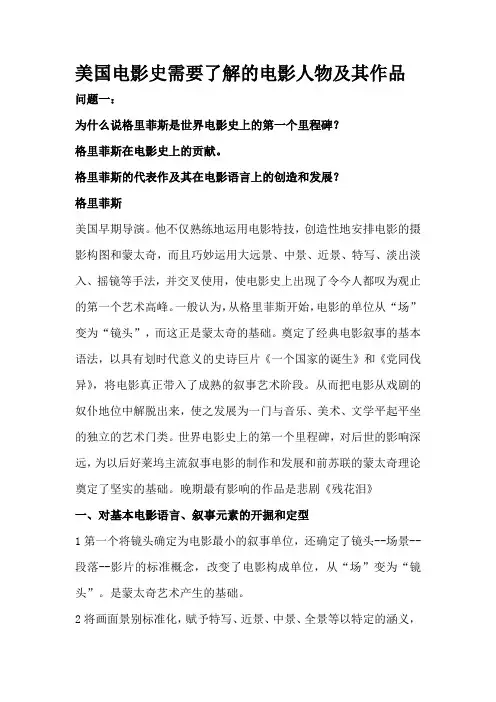美国电影史资料
- 格式:ppt
- 大小:4.32 MB
- 文档页数:78






美国电影史
美国电影正式以1893年被称为“第一部美国电影”的《劳伦斯’幻灯片》和以1902年的《爱情的诱惑》为开端,其以其经典的风格,创新的视觉技术和无与伦比的故事情节受到了世界范围内各国电影
观众的一致好评。
从那时起,美国电影就以其精湛的技术,精彩的故事情节,贴切的音乐,精心打造的效果,流行的模式及技术突破而被人们津津乐道。
美国电影的发展历程,可以从早期风格的发展开始,从影片的原始题材,技术及道德的变迁,以及电影的不断发展。
早期的美国电影,以短片为主,一般伴随着朴实的舞蹈和音乐,这种短片主要以搞笑片、爱情片、革命片、公认经典电影,及各种华丽的画面、情节拖拉而成,用视觉和听觉效果来引起观众的注意力。
随着时代的发展,美国电影逐渐发展出自己的风格,电影的题材也发生了变化,从单一的搞笑片、爱情片,发展到较为复杂的历史片,战争片,犯罪片,家庭片,科幻片等类型的电影的多元化,满足不同受众的不同需求。
电影技术也发生了巨大的变化,电影从原来的单一摄影技术,到现在复杂而精确的电影技术,使电影效果可以更准确地反映出生活中的各种状态,让观众可以更真实地感受到影片中的戏剧效果。
此外,从电影中可以看出美国电影史中的道德价值和价值观的转变,早期的电影道德较为保守,但由于社会的不断发展,正义观念的提升,电影的道德观越来越创新,既体现当下社会的现实又表达人们
的价值观。
美国电影史也在不断发展,不断地引进新的技术,将电影创作发扬光大,使影迷们可以更高效地体会多样的电影内容,增强他们对美国电影这门艺术的热爱和了解。
美国电影作出了巨大的贡献,不论精神层次或文化层次上,都被认为是一项重大的文化成就,对于全世界的影迷的熏陶是巨大的,也给世界文化带来了更多的精彩和创新。





美国电影史需要了解的电影人物及其作品问题一:为什么说格里菲斯是世界电影史上的第一个里程碑?格里菲斯在电影史上的贡献。
格里菲斯的代表作及其在电影语言上的创造和发展?格里菲斯美国早期导演。
他不仅熟练地运用电影特技,创造性地安排电影的摄影构图和蒙太奇,而且巧妙运用大远景、中景、近景、特写、淡出淡入、摇镜等手法,并交叉使用,使电影史上出现了令今人都叹为观止的第一个艺术高峰。
一般认为,从格里菲斯开始,电影的单位从“场”变为“镜头”,而这正是蒙太奇的基础。
奠定了经典电影叙事的基本语法,以具有划时代意义的史诗巨片《一个国家的诞生》和《党同伐异》,将电影真正带入了成熟的叙事艺术阶段。
从而把电影从戏剧的奴仆地位中解脱出来,使之发展为一门与音乐、美术、文学平起平坐的独立的艺术门类。
世界电影史上的第一个里程碑,对后世的影响深远,为以后好莱坞主流叙事电影的制作和发展和前苏联的蒙太奇理论奠定了坚实的基础。
晚期最有影响的作品是悲剧《残花泪》一、对基本电影语言、叙事元素的开掘和定型1第一个将镜头确定为电影最小的叙事单位,还确定了镜头--场景--段落--影片的标准概念,改变了电影构成单位,从“场”变为“镜头”。
是蒙太奇艺术产生的基础。
2将画面景别标准化,赋予特写、近景、中景、全景等以特定的涵义,并形成了经典电影叙事的全景-中景-近景/特写的镜头语言;发展了大特写、大远景等一系列电影语言,并创造性的运用近景特写表现情绪。
二、对电影写实功能和表意功能的进一步探究1有意识的系统的使用运动镜头,如摇镜头、移动镜头及景深镜头,还发明了圈入圈出、淡入淡出的技巧2他根据镜头的情绪内容决定画面的选择,包括构图、光线、景别,用剪辑来控制情绪和节奏3首先使用三维立体的真实布景和表意性的灯光照明4注重对演员和表演要求,培养了一批优秀演员,开创了好莱坞明星制度的先河。
三、对电影剪辑、电影时空和电影节奏所作的创新1丰富了电影的结构,创造平行剪辑,创造了著名的“最后一分钟营救”。
美国电影发展史Of all the products of popular culture, none is more sharply etched in our collective imagination than the movies. Most Americans ins tantly recognize images produced by the movies: Charlie Chaplin, t he starving prospector in The Gold Rush, eating his shoe, treating t he laces like spaghetti. Paul Muni, the jobless World War I veteran in I am a Fugitive from a Chain Gang, who is asked how he live s and replies, "I steal." Gloria Swanson, the fading movie goddess in Sunset Boulevard, belittling suggestions that she is no longer a b ig star: "It's the pictures that got small."Movies are key cultural artifacts that offer a window into Ameri can cultural and social history. A mixture of art, business, and pop ular entertainment, the movies provide a host of insights into Ameri cans' shifting ideals, fantasies, and preoccupations. Like any cultural artifact, the movies can be approached in a variety of ways. Cultu ral historians have treated movies as sociological documents that rec ord the look and mood of particular historical settings; as ideologic al constructs that advance particular political or moral values or my ths; as psychological texts that speak to individual and social anxiet ies and tensions; as cultural documents that present particular image s of gender, ethnicity, class romance, and violence; and as visual te xts that offer complex levels of meaning and seeing.Beside Macy's Department Store in Herald Square New York Cit y there is a plaque commemorating the first public showing of a m otion picture on a screen in the United States. It was here, on Apri l 23, 1896, at Koster and Bial's Music Hall in New York City, tha t Thomas Alva Edison presented a show included scenes of the sur f breaking on a beach, a comic boxing exhibition, and two young women dancing. A review in The New York Times described the e xhibition as "all wonderfully real and singularly exhilarating."The first successful efforts to project lifelike images on a screen took place in the mid-seventeenth century. By 1659, a Dutch scien tist named Christiaen Huygens had invented the magic lantern, the forerunner of the modern slide projector, which he used to project medical drawings before an audience.The first true moving images appeared in the 1820s, when the c oncept of the persistence of vision was used to create children's toy s and other simple entertainments. The thaumatrope, which appeared in 1826, was a simple disk with separate images printed on each side (for example, a bird on one side and a cage on another). Whe n rapidly spun, the images appeared to blend together (so that the bird seemed to be inside the cage). A simpler way to display move ment was the flip book, which became popular by the late 1860s.Each page showed a subject in a subtly different position. When a reader flipped the book's pages, the pictures gave the illusion of m ovement.In 1887, Thomas Edison gave William K.L. Dickson, one of his leading inventors, the task of developing a motion picture apparatu s. Edison envisioned a machine "that should do for the eye what th e phonograph did for the ear." Dickson initially modeled his device on Edison's phonograph, placing tiny pictures on a revolving drum.A light inside the drum was supposed to illuminate the pictures. T hen he decided to use the flexible celluloid film that George Eastm an had invented in 1880 and had begun to use in his Kodak camer a. Dickson added perforations to the edge of the film strip to help it feed evenly into his camera.To display their films, Dickson and Edison devised a coin-operat ed peepshow device called a "kinetoscope." Because the kinetoscope could only hold fifty feet of film, its films lasted just 35 to 40 se conds. This was too brief to tell a story; the first kinetoscope films were simply scenes of everyday life, like the first film "Fred Ott's Sneeze," reenactments of historical events, photographed bits of va udeville routines, and pictures of well-known celebrities. Nevertheles s, the kinetoscope was an instant success. By 1894, coin-operated kinetoscopes had begun to appear in hotels, department stores, saloon s, and amusement arcades called nickelodeons. In 1894, the Lumier e brothers introduced the portable motion picture camera and projec tor.Finally recognizing the potential of the motion picture projector, Edison entered into an agreement with a Washington, D.C. realtor, Thomas Armat, who had designed a workable projector. In April, 1 896, the two men unveiled the Vitascope and presented the first m otion pictures on a public screen in the United States.Competition in the early movie industry was fierce. To force the ir competitors out of the industry, moviemakers turned to the courts, launching over two hundred patent infringement suits. To protect t heir profits and bring order to the industry, Edison and a number o f his competitors decided to cooperate by establishing the Motion P icture Patents Company in 1909, consisting of six American compa nies and two French firms. Members of the trust agreed that only t hey had the right to make, print, or distribute cameras, projectors, or films. The trust also negotiated an exclusive agreement with East man Kodak for commercial quality film stock.During film's first decade from 1896 to 1905 movies were little more than a novelty, often used as a "chaser" to signal the end ofa show in a vaudeville theater. These early films are utterly unlik e anything seen today. They lasted just seven to ten minutes -toob rief to tell anything more than the simplest story. They used a cast of anonymous actors for the simple reason that the camera was se t back so far that it was impossible to clearly make out the actors' faces. As late as 1908, a movie actor made no more than $8 a d ay and received no credit on the screen.In 1905, hundreds of little movie theaters opened, called nickelo deons, since they sold admission nickel by nickel. By 1908, there were an estimated 8,000 to 10,000 nickelodeons. Contrary to popula r belief, the nickelodeon's audience was not confined to the poor, t he young, or the immigrant. From the start, theaters were situated i n rural areas and middle class neighborhoods as well as working-cl ass neighborhoods. Nevertheless, the movies attracted audiences of a n unprecedented size, as a result of their low admission prices, "de mocratic" seating arrangements, convenient time schedules (films we re shown again and again), and lack of spoken dialogue, which allo wed non- English speaking immigrants to enjoy films.By 1907, narrative films had begun to increase in number. But most films still emphasized stunts and chases and real life events-li ke scenes of yacht races or train crashes--and were rented or soldby the foot regardless of subject matter. Exhibitors were expected t o assemble scenes together to form a larger show.The formation of the movie trust ushered in a period of rationali zation within the film industry. Camera and projecting equipment w as standardized; film rental fees were fixed; theaters were upgraded; and the practice of selling films outright ended, which improved t he quality of movies by removing damaged prints from circulation. This was also a period intense artistic and technical innovation, as pioneering directors like David Wark Griffith and others created a new language of film and revolutionized screen narrative.By focusing the camera on particular actors and actresses, Griffit h inadvertently encouraged the development of the star system. As early as 1910, newspapers were deluged with requests for actors' na mes. But most studios refused to divulge their identities, fearing the salary demands of popular performers. But the film trust's leading opponent, Carl Laemmle, was convinced that the key to the financi al stability lay in producing films featuring popular stars. As one in dustry observer put it, "In the 'star' your producer gets not only a ' production' value...but a 'trademark' value, and an 'insurance' value which are...very potent in guaranteeing the sale of this product." In 1910, Laemmle produced the first star; he lured Florence Lawrence, the most popular anonymous star, away from Biograph, and laun ched an unprecedented publicity campaign on her behalf. As the sta r system emerged, salaries soared. In the course of just two years, the salary of actress Mary Pickford rose from less than $400 a wee k in 1914 to $10,000 a week in 1916.During the second decade of the twentieth century, immigrants li ke Laemmle and Zukor came to dominate the movie business. Unli ke Edison and the other American-born, Protestant businessmen who had controlled the early film industry, these immigrant entrepreneu rs had a better sense of what the public wanted to see. Virtually al l of these new producers emigrated to the United States from centr al Europe and were Jewish. Less conservative than the American-bo rn producers, they were more willing to experiment with such inno vations as the star system and feature-length productions. Since man y had come to the film industry from the garment and fur trades where fashions change rapidly and the successful businessman is on e who stays constantly in touch with the latest styles, they tried to give the public what it wanted.As Samuel Goldwyn, one of the leading moguls, noted, "If the audience don't like a picture, they have a good reason. The public is never wrong. I don't go for all this thing that when I have a failure, it is because the audience doesn't have the taste or education, or isn't sensitive enough. The public pays money. It wants to be e ntertained. That's all I know." With this philosophy the outsiders wr estled control over the industry away from the American-born produ cers.During the 1920s and 1930s, a small group of film companies cons olidated their control. Known as the "Big Five" - Paramount, Warn er Brothers, RKO, 20th Century-Fox, and Lowe's (MGM) and the " Little Three" - Universal, Columbia, and United Artists, they forme d fully integrated companies. With the exception of United Artists, which was solely a distribution company, the "majors" owned their own production facilities, ran their own worldwide distribution netw orks, and controlled theater chains that were committed to showing the company's products. And at the head of each major studio was a powerful mogul such giants as Adolph Zukor, Wiliam Fox, Loui s B. Mayer, Samuel Goldwyn, Carl Laemmle, Harry Cohn, Joseph Schenck, and the Warner Brothers who determined what the public was going to see. It was their vision--patriotic, sentimental, secular, and generally politically conservative which millions of Americans shared weekly at local movie theaters.During the 1920s, movie attendance soared. By the middle of th e decade, 50 million people a week went to the movies - the equi valent of half the nation's population. In Chicago, in 1929, theaters had enough seats for half the city's population to attend a movie each day.In 1926, Warner Brothers released the film Don Juan--the first fi lm with a synchronized film score--along with a program of talking shorts. The popularity of The Jazz Singer, which was released in 1927, erased any doubts about the popular appeal of sound, and wi thin a year, 300 theaters were wired for sound.The arrival of sound produced a sharp upsurge in movie attenda nce, which jumped from 50 million a week in the mid-20s to 110 million in 1929. But it also produced a number of fundamental tran sformations in the movies themselves. As Robert Ray has shown, s ound made the movies more American. The introduction of sound a lso encouraged new film genres--like the musical, the gangster film, and comedies that relied on wit rather than slapstick.In addition, the talkies dramatically changed the movie- going ex perience, especially for the working class. Where many working cla ss audiences had provided silent films with a spoken dialogue, mov ie-goers were now expected to remain quiet. As one film historianhas observed: "The talking audience for silent pictures became a sil ent audience for talking pictures. "Moreover, the stage shows and o ther forms of live entertainment that had appeared in silent movie houses increasingly disappeared, replaced by newsreels and animated shorts.The film industry changed radically after World War II, and this change altered the style and content of the films made in Hollywo od. After experiencing boom years from 1939 to 1946, the film ind ustry began a long period of decline. Within just seven years, atten dance and box receipts fell to half their 1946 levels.During the 1940s, a new film genre--known as film noir-- arose, which gave tangible expression to the psychic confusion of a natio n that had won the largest war in history but faced even greater u ncertainties in peacetime. Though film noir received its named from French film critics and was heavily influenced by German expressi onist film making techniques, it stands out as one of the most origi nal and innovative American movie genres.After the war, Hollywood's audience not only shrank, it also fra gmented into distinct subgroups. An audience interested in serious s ocial problem films expanded. During the postwar period Hollywoo d produced a growing number addressing such problems as ethnic and racial prejudice, anti-Semitism, sufferings of maltreated mental p atients, and the problems of alcohol and drug addiction. The growin g popularity of science fiction thrillers also reflected the emergence of the youth market and the spread of a certain paranoid style dur ing the Cold War years.As the 1960s began, few would have guessed that the decade w ould be one of the most socially conscious and stylistically innovati ve in Hollywood's history. Among the most popular films at the de cade's start were Doris Day romantic comedies like That Touch of Mink (1962) and epic blockbusters like The Longest Day (1962), L awrence of Arabia (1962), and Cleopatra (1963). Yet, as the decade progressed, Hollywood radically shifted focus and began to produc e an increasing number of anti-establishment films, laced with socia l commentary, directed at the growing youth market. Two films rel eased in 1967--Bonnie and Clyde and The Graduate--awoke Hollyw ood to the size and influence of the youth audience.A number of most influential films of the late '60s and early '70 s sought to revise older film genres--like the war film, the crime fi lm, and the western--and rewrite Hollywood's earlier versions of A merican history from a more critical perspective. Francis Ford Copp ola's The Godfather (1972) revised and enhanced the gangster genreby transforming it into a critical commentary on an immigrant fam ily's pursuit of the American dream.During the mid- and late-70s, the mood of American films shifte d sharply. Unlike the highly politicized films of the early part of t he decade, the most popular films of the late 1970s and early 1980 s were escapist blockbusters like Star Wars (1977), Superman (197 8), and Raiders of the Lost Ark (1981)-- featuring spectacular speci al effects, action, and simplistic conflicts between good and evil--in spirational tales of the indomitable human spirit, like Rocky (1976)--or nostalgia for a more innocent past--like Animal House (1978) a nd Grease (1978).In a 1992 bestseller Hollywood vs. America, Michael Medved, co-h ost of public television's Sneak Previews, described Hollywood as a "poison factory," befouling America's moral atmosphere and assault ing the country's "most cherished values." Today's films, he argued, use their enormous capacity to influence opinion by glamorizing vi olence, maligning marriage, mocking authority, promoting sexual pro miscuity, ridiculing religion, and bombarding viewers with an endles s stream of profanity, gratuitous sex, and loutish forms of behavior. Where once the movies offered sentiment, elegance, and romance, now, Medved contends, ideologically-motivated producers and directors promote their own divisive agenda: anti-religion, anti-family, ant i-military.Nevertheless, as the movie industry enters its second century, ma ny Americans worry about Hollywood's future. Medved is not alone in complaining that "they don't make movies like they used to." A basic problem facing today's Hollywood is the rapidly rising cost of making and marketing a movie: an average of $40 million today. The immense cost of producing movies has led the studios to see k guaranteed hits: blockbuster loaded with high-tech special effects, sequels, and remakes of earlier movies, foreign films, and even ol d TV shows.For a century, the movie industry has been the nation's most im portant purveyor of culture and entertainment to the masses, playing a critical role in the shift from Victorian to distinctively modern, consumer values; from a world of words to a visual culture; from a society rooted in islands of localities and ethnic groups to a com mercialized mass culture. The movies taught Americans how to kiss, make love, conceive of gender roles, and understand their place in the world. Whether film will continue to serve as the nation's pree minent instrument of cultural expression--reflecting and also shaping values and cultural ideals--remains to be seen.1893年,T.A.爱迪生发明电影视镜并创建“囚车”摄影场,被视为美国电影史的开端。
美国是电影王国,电影娱乐业是美国的支柱产业之一。
美国电影以其独特的形式最大限度地体现和展示了美国人的精神和物质生活,现在已经渗透到了世界各地日常生活的每一个角落,影响到全球各国人民的生活方式。
一、美国电影产业发展历程总览美国电影产业发展历程二、无声电影开启电影文化之门1893 年,爱迪生发明电影视镜并创建“囚车”摄影场,被视为美国电影史的开端。
1896 年,维太放映机的推出开始了美国电影的群众性放映。
由于技术的限制,最开始美国电影都是无声电影,因而这一时期也常称作“默片时代”。
20 世纪末20 世纪初,美国的城市工业发展和中下层居民迅速增多,电影成为适应城市平民需要的一种大众娱乐。
它起先在歌舞游乐场内,随后进人小剧场,在剧目演出之后放映。
上流社会认为电影表现粗俗,对其不屑一顾,电影院变成下层人士的聚集地。
这种情况直到20 世纪20 年代才有所改观。
1905 年在匹兹堡出现的镍币影院(入场券为5 美分镍币)很快遍及美国所有城镇,到1910 年每周的电影观众多达3600 万人次。
当时影片都是单本一部的,产量每月400 部,主要制片基地在纽约,如爱迪生公司、比沃格拉夫公司和维太格拉夫公司。
由于电影收益高,所以引发了激烈的竞争。
1897 年,爱迪生为争夺专利进行诉讼,到1908 年,成立了由爱迪生控制的电影专利公司,公司拥有16 项专利权。
到1910 年,电影专利公司垄断了美国电影的制作、发行和放映。
独立制片商为摆脱专利公司的垄断,相继到远离纽约和芝加哥的洛杉矶郊外小镇好莱坞去拍片,那里自然条件得天独厚,又临近墨西哥边境,一旦专利公司提出诉讼便可逃离。
格里菲斯1907 年加入比沃格拉夫公司,次年导演了第一部影片《陶丽历险记》。
至1912 年已为该公司摄制了近400 部影片,把拍片重心逐渐移向好莱坞,并发现和培养了许多后来的名演员,如塞纳-马恩省特、壁克馥和吉许姐妹等。
第一次世界大战前夕,镍币影院逐渐被一些条件较好的电影院所代替;电影专利公司的垄断权势逐渐消失,终于在1915 年正式解体。